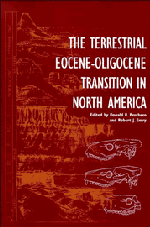Book contents
- Frontmatter
- Contents
- Contributors
- Preface
- PART I The Chronostratigraphy of the Uintan through Arikareean
- PART II Common Vertebrates of the White River Chronofauna
- 16 Testudines
- 17 Squamata
- 18 Ischyromyidae
- 19 Cylindrodontidae
- 20 Castoridae
- 21 Canidae
- 22 Nimravidae
- 23 Amphicyonidae
- 24 Small Arctoid and Feliform Camivorans
- 25 Merycoidodontinae and Miniochoerinae
- 26 Leptaucheniinae
- 27 Leptomerycidae
- 28 Camelidae
- 29 Hyracodontidae
- Summary
- Index
17 - Squamata
Published online by Cambridge University Press: 06 July 2010
- Frontmatter
- Contents
- Contributors
- Preface
- PART I The Chronostratigraphy of the Uintan through Arikareean
- PART II Common Vertebrates of the White River Chronofauna
- 16 Testudines
- 17 Squamata
- 18 Ischyromyidae
- 19 Cylindrodontidae
- 20 Castoridae
- 21 Canidae
- 22 Nimravidae
- 23 Amphicyonidae
- 24 Small Arctoid and Feliform Camivorans
- 25 Merycoidodontinae and Miniochoerinae
- 26 Leptaucheniinae
- 27 Leptomerycidae
- 28 Camelidae
- 29 Hyracodontidae
- Summary
- Index
Summary
ABSTRACT
The central North American squamatofauna is best preserved in the Orellan-aged strata, where it has its greatest diversity. By contrast the Chadronian and Whitneyan intervals are much less diverse with respect to genera present which may, in part, reflect preservation biases. Unlike the European squamatofauna associated with the “Grande Coupure,” the North American squamatofauna has some taxa in common on both sides of the Eocene/Oligocene boundary, and persistence of some genera into the Miocene, and later Cenozoic, suggest that the transition of this part of the central North American herpetofauna was stepwise in nature.
A re-evaluation of the systematics of the Eocene-Oligocene Squamata from central North America (Great Plains and adjacent eastern Rocky Mountain regions) suggests a squamatofauna that is more primitive than previously thought. Prior taxonomic assignments of some fossil lizards have been based largely on primitive characters that permitted assignment to a few late Neogene-Recent taxa. Some other lizard (and snake) taxa, which included numerous species, are largely now demonstrably monotypic.
A synopsis of our study concludes that Aciprion is a sister taxon to the iguanines and is a monotypic taxon (A. formosum). Paraphrynosoma (new genus) is established for the species P. greeni, which was originally diagnosed largely by primitive features and is considered a sister taxon to, and differs from, Recent Phrynosoma. Aciprion formosum, Crotaphytus? oligocenicus, Cypressaurus hypsodontus, Paraphrynosoma greeni, cannot be assigned to any modern day families of Iguania owing to their plesiomorphic nature, and are designated Iguania incertae sedis.
- Type
- Chapter
- Information
- The Terrestrial Eocene-Oligocene Transition in North America , pp. 354 - 372Publisher: Cambridge University PressPrint publication year: 1996
- 11
- Cited by



